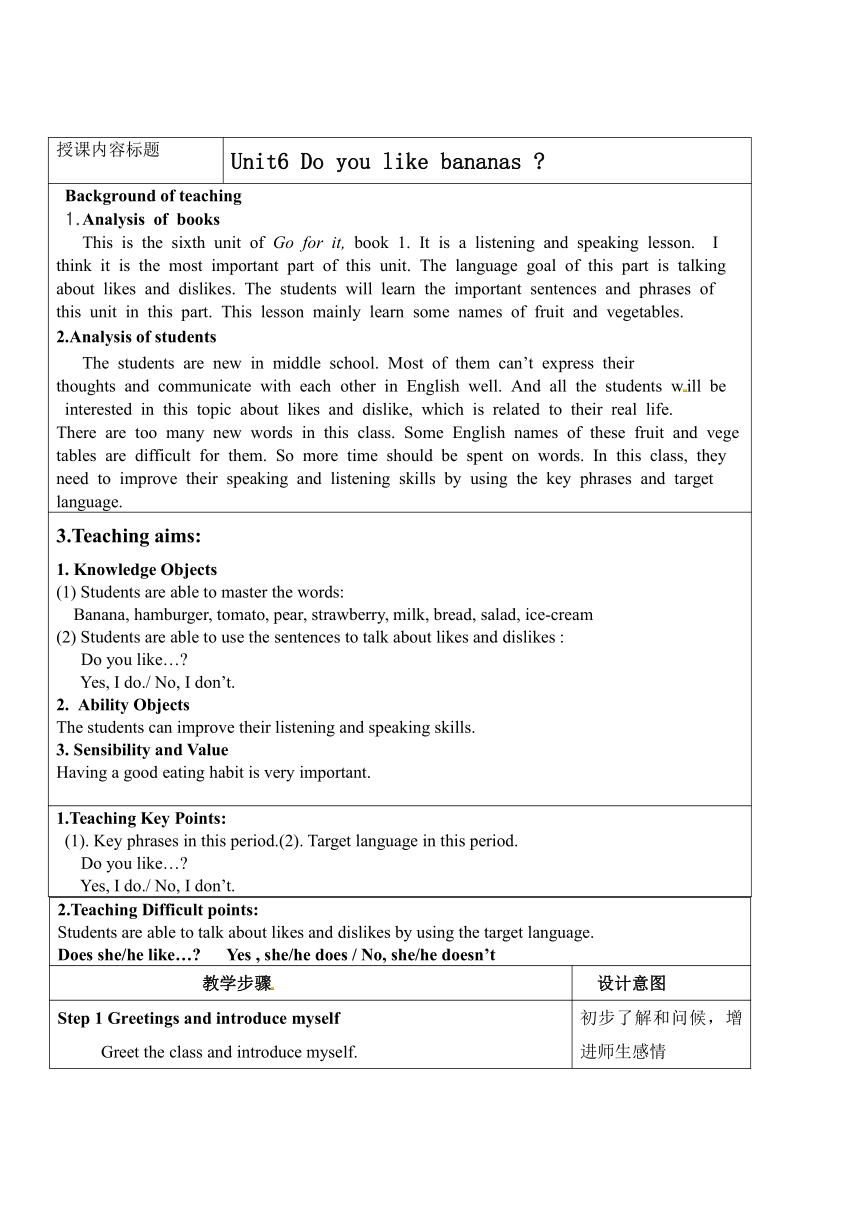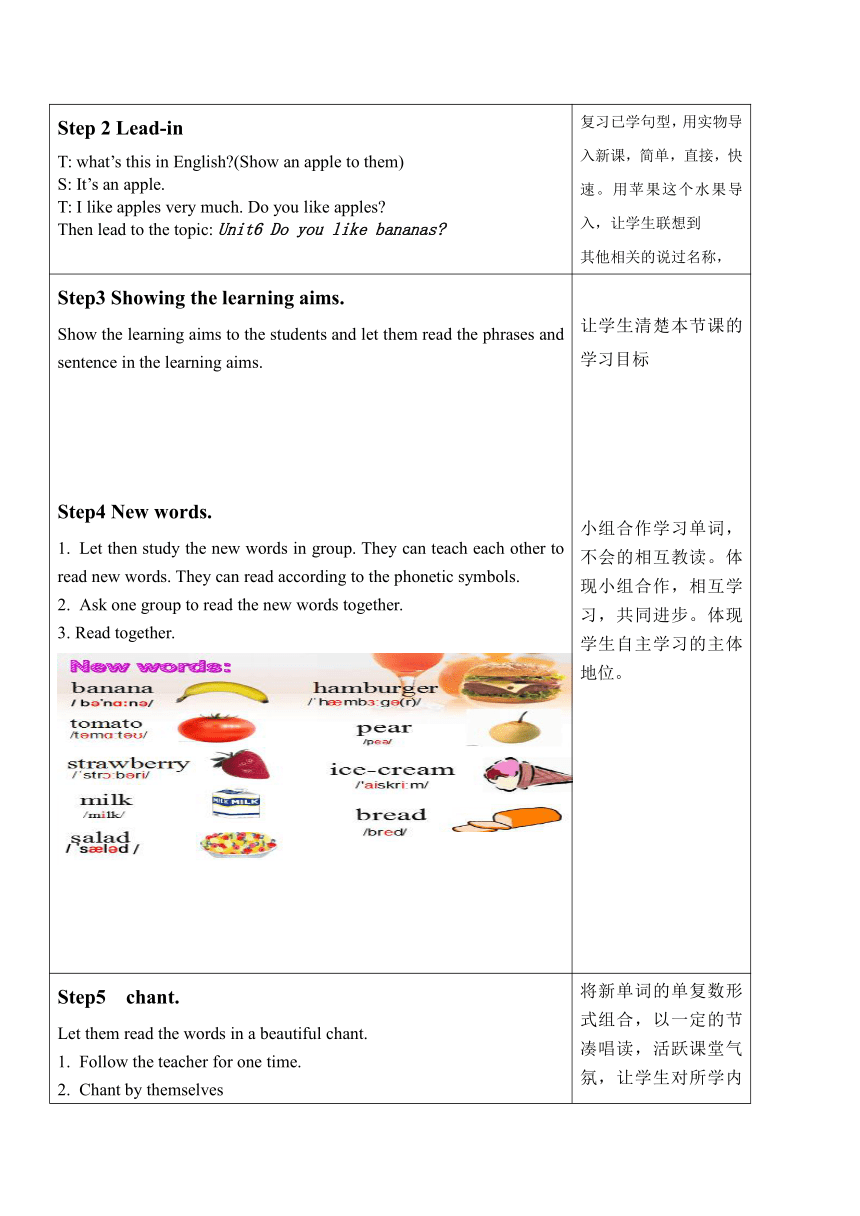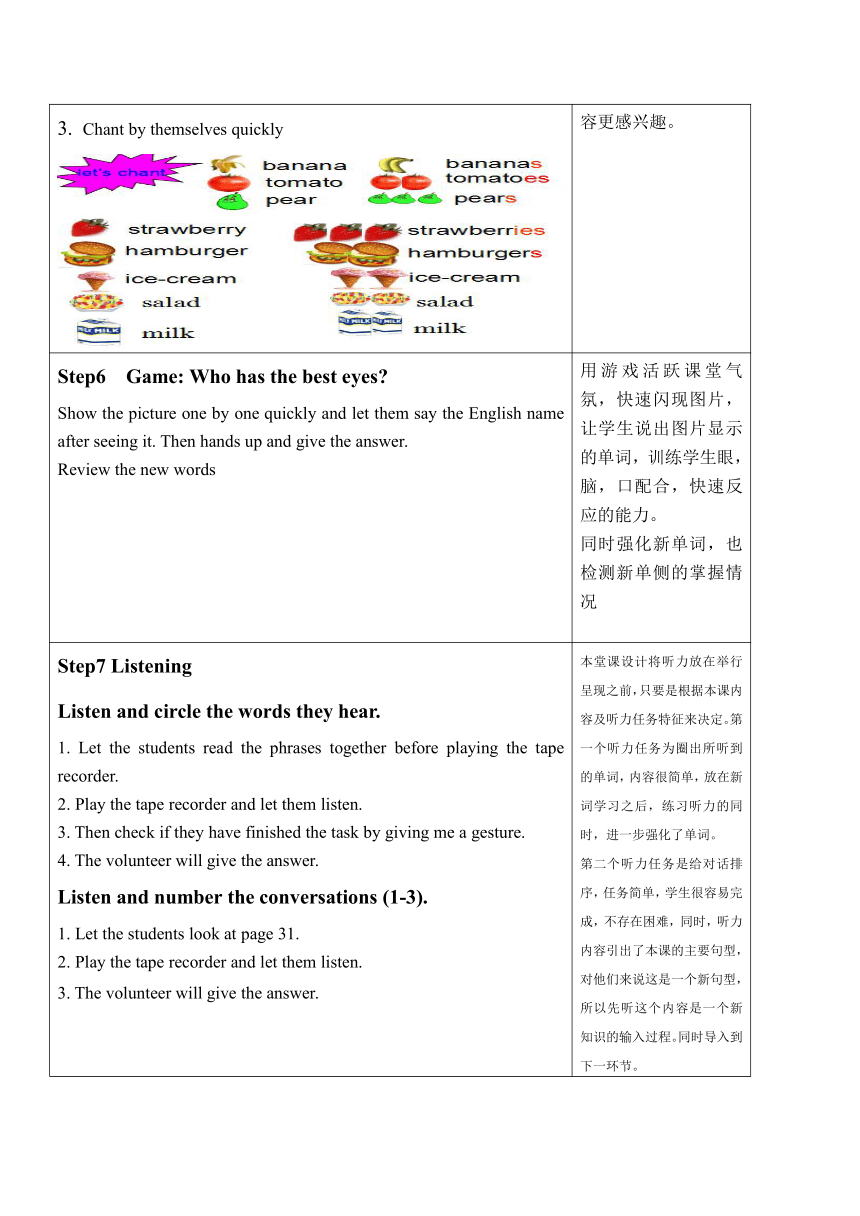人教版七年级上册英语 6.Do you like bananas?SectionA 1a-2d 教案
文档属性
| 名称 | 人教版七年级上册英语 6.Do you like bananas?SectionA 1a-2d 教案 |  | |
| 格式 | doc | ||
| 文件大小 | 584.0KB | ||
| 资源类型 | 教案 | ||
| 版本资源 | 人教新目标(Go for it)版 | ||
| 科目 | 英语 | ||
| 更新时间 | 2022-11-01 09:47:39 | ||
图片预览



文档简介
授课内容标题 Unit6 Do you like bananas
Background of teaching 1.Analysis of books This is the sixth unit of Go for it, book 1. It is a listening and speaking lesson. I think it is the most important part of this unit. The language goal of this part is talkingabout likes and dislikes. The students will learn the important sentences and phrases of this unit in this part. This lesson mainly learn some names of fruit and vegetables.2.Analysis of students The students are new in middle school. Most of them can’t express their thoughts and communicate with each other in English well. And all the students will be interested in this topic about likes and dislike, which is related to their real life.There are too many new words in this class. Some English names of these fruit and vegetables are difficult for them. So more time should be spent on words. In this class, they need to improve their speaking and listening skills by using the key phrases and target language.
3.Teaching aims:1. Knowledge Objects(1) Students are able to master the words: Banana, hamburger, tomato, pear, strawberry, milk, bread, salad, ice-cream(2) Students are able to use the sentences to talk about likes and dislikes : Do you like… Yes, I do./ No, I don’t. Ability ObjectsThe students can improve their listening and speaking skills.3. Sensibility and ValueHaving a good eating habit is very important.
1.Teaching Key Points: (1). Key phrases in this period.(2). Target language in this period.Do you like… Yes, I do./ No, I don’t.
2.Teaching Difficult points:Students are able to talk about likes and dislikes by using the target language.Does she/he like… Yes , she/he does / No, she/he doesn’t
教学步骤 设计意图
Step 1 Greetings and introduce myself Greet the class and introduce myself. 初步了解和问候,增进师生感情
Step 2 Lead-inT: what’s this in English (Show an apple to them)S: It’s an apple. T: I like apples very much. Do you like apples Then lead to the topic: Unit6 Do you like bananas 复习已学句型,用实物导入新课,简单,直接,快速。用苹果这个水果导入,让学生联想到其他相关的说过名称,
Step3 Showing the learning aims.Show the learning aims to the students and let them read the phrases and sentence in the learning aims.Step4 New words.Let then study the new words in group. They can teach each other to read new words. They can read according to the phonetic symbols.Ask one group to read the new words together.3. Read together. 让学生清楚本节课的学习目标小组合作学习单词,不会的相互教读。体现小组合作,相互学习,共同进步。体现学生自主学习的主体地位。
Step5 chant.Let them read the words in a beautiful chant. Follow the teacher for one time.Chant by themselvesChant by themselves quickly 将新单词的单复数形式组合,以一定的节凑唱读,活跃课堂气氛,让学生对所学内容更感兴趣。
Step6 Game: Who has the best eyes Show the picture one by one quickly and let them say the English name after seeing it. Then hands up and give the answer.Review the new words 用游戏活跃课堂气氛,快速闪现图片,让学生说出图片显示的单词,训练学生眼,脑,口配合,快速反应的能力。同时强化新单词,也检测新单侧的掌握情况
Step7 ListeningListen and circle the words they hear. 1. Let the students read the phrases together before playing the tape recorder.2. Play the tape recorder and let them listen.3. Then check if they have finished the task by giving me a gesture.4. The volunteer will give the answer. Listen and number the conversations (1-3). 1. Let the students look at page 31.2. Play the tape recorder and let them listen.3. The volunteer will give the answer. 本堂课设计将听力放在举行呈现之前,只要是根据本课内容及听力任务特征来决定。第一个听力任务为圈出所听到的单词,内容很简单,放在新词学习之后,练习听力的同时,进一步强化了单词。第二个听力任务是给对话排序,任务简单,学生很容易完成,不存在困难,同时,听力内容引出了本课的主要句型,对他们来说这是一个新句型,所以先听这个内容是一个新知识的输入过程。同时导入到下一环节。
Step8 PresentationShow a picture of the bananas and ask the students :what are these They answer: They are bananas.Then ask them: Do you like bananas They can answer: Yes, I do./No, I don’t.Divide the students into boys and girls, and let them ask and answer in the two big groups twice.Ask one student to stand up, and others ask her/him this question.Show a picture of the tomatoes and ask the students :what are these They answer: They are tomatoes.Then ask them: Do you like tomatoes They can answer: Yes, I do. I like tomatoes. /No, I don’t. I don’ like tomatoes.(let them learn to say : I like... , I don’t like...)Then let then ask the question one by one in their group (Happy train game).Pair work. Show other pictures together,then let them make their conversations by using other words. Give them 2minutes. Then ask them show their conversations.Ask other students to listen carefully and check by ask : T: Does she/he like... Ss: Yes, she/he does. She likes ... / No, she/he doesn’t. She doesn’t like... 这是本节课的一个重要环节,呈现主要句型和强化新单词。将两者融合操练,让学生同时学习句型和强化单词。句子呈现从简到繁,从易到难,让学生容易接受,学懂。在句子强化过程中,以老师提问个人,全班提问个人,同桌问同桌,小组内开火车(用“推火车”的方法让更多学生得到练习。),及两人对话的形式训练。对新知识学习达到一定的强化次数。让全部学生开口说,听他们说,同时训练口语和听力。达到听说课的目的。对学生听力的检测主要是让学生养成认真听的良好习惯,同时也是一种文明礼仪的培养。
step8 survey1.Let each group chooses a student as a reporter. He/she interviews others in your group about what do they like or dislike, then make a report. they will have 3minuts to interview others.Then I will choose 3-4 groups to give the report. 这是学生的一个能力提升部分,是口语的强化训练步骤。这个过程不仅训练学生说的能力,还培养他们团体合作能力。
Step9 Let's play a game(选择礼盒,得到你想要的惊喜)This is a funny game. The students will choose the gift boxes and do the exercise, then get the score it given. Each group have one time. 这将会是学生非常喜欢的一个环节,将练习和检测步骤用游戏的形式完成,激发学生的兴趣,同时检测他们对本课内容的掌握情况。
Step10 summaryWork in group and summarize:what have we learned today let them the news by themselves. Then exchange the exercise books in their group. Find out the missing words.Ask a group to read out the words together.The teacher summarize the sentences, ask them to read the main sentences together.(which are on the board.)Tell them some good eating habits. 以小组合作形式总结本课所学内容。体现小组合作,人人参与总结,发现自己的不足。
Background of teaching 1.Analysis of books This is the sixth unit of Go for it, book 1. It is a listening and speaking lesson. I think it is the most important part of this unit. The language goal of this part is talkingabout likes and dislikes. The students will learn the important sentences and phrases of this unit in this part. This lesson mainly learn some names of fruit and vegetables.2.Analysis of students The students are new in middle school. Most of them can’t express their thoughts and communicate with each other in English well. And all the students will be interested in this topic about likes and dislike, which is related to their real life.There are too many new words in this class. Some English names of these fruit and vegetables are difficult for them. So more time should be spent on words. In this class, they need to improve their speaking and listening skills by using the key phrases and target language.
3.Teaching aims:1. Knowledge Objects(1) Students are able to master the words: Banana, hamburger, tomato, pear, strawberry, milk, bread, salad, ice-cream(2) Students are able to use the sentences to talk about likes and dislikes : Do you like… Yes, I do./ No, I don’t. Ability ObjectsThe students can improve their listening and speaking skills.3. Sensibility and ValueHaving a good eating habit is very important.
1.Teaching Key Points: (1). Key phrases in this period.(2). Target language in this period.Do you like… Yes, I do./ No, I don’t.
2.Teaching Difficult points:Students are able to talk about likes and dislikes by using the target language.Does she/he like… Yes , she/he does / No, she/he doesn’t
教学步骤 设计意图
Step 1 Greetings and introduce myself Greet the class and introduce myself. 初步了解和问候,增进师生感情
Step 2 Lead-inT: what’s this in English (Show an apple to them)S: It’s an apple. T: I like apples very much. Do you like apples Then lead to the topic: Unit6 Do you like bananas 复习已学句型,用实物导入新课,简单,直接,快速。用苹果这个水果导入,让学生联想到其他相关的说过名称,
Step3 Showing the learning aims.Show the learning aims to the students and let them read the phrases and sentence in the learning aims.Step4 New words.Let then study the new words in group. They can teach each other to read new words. They can read according to the phonetic symbols.Ask one group to read the new words together.3. Read together. 让学生清楚本节课的学习目标小组合作学习单词,不会的相互教读。体现小组合作,相互学习,共同进步。体现学生自主学习的主体地位。
Step5 chant.Let them read the words in a beautiful chant. Follow the teacher for one time.Chant by themselvesChant by themselves quickly 将新单词的单复数形式组合,以一定的节凑唱读,活跃课堂气氛,让学生对所学内容更感兴趣。
Step6 Game: Who has the best eyes Show the picture one by one quickly and let them say the English name after seeing it. Then hands up and give the answer.Review the new words 用游戏活跃课堂气氛,快速闪现图片,让学生说出图片显示的单词,训练学生眼,脑,口配合,快速反应的能力。同时强化新单词,也检测新单侧的掌握情况
Step7 ListeningListen and circle the words they hear. 1. Let the students read the phrases together before playing the tape recorder.2. Play the tape recorder and let them listen.3. Then check if they have finished the task by giving me a gesture.4. The volunteer will give the answer. Listen and number the conversations (1-3). 1. Let the students look at page 31.2. Play the tape recorder and let them listen.3. The volunteer will give the answer. 本堂课设计将听力放在举行呈现之前,只要是根据本课内容及听力任务特征来决定。第一个听力任务为圈出所听到的单词,内容很简单,放在新词学习之后,练习听力的同时,进一步强化了单词。第二个听力任务是给对话排序,任务简单,学生很容易完成,不存在困难,同时,听力内容引出了本课的主要句型,对他们来说这是一个新句型,所以先听这个内容是一个新知识的输入过程。同时导入到下一环节。
Step8 PresentationShow a picture of the bananas and ask the students :what are these They answer: They are bananas.Then ask them: Do you like bananas They can answer: Yes, I do./No, I don’t.Divide the students into boys and girls, and let them ask and answer in the two big groups twice.Ask one student to stand up, and others ask her/him this question.Show a picture of the tomatoes and ask the students :what are these They answer: They are tomatoes.Then ask them: Do you like tomatoes They can answer: Yes, I do. I like tomatoes. /No, I don’t. I don’ like tomatoes.(let them learn to say : I like... , I don’t like...)Then let then ask the question one by one in their group (Happy train game).Pair work. Show other pictures together,then let them make their conversations by using other words. Give them 2minutes. Then ask them show their conversations.Ask other students to listen carefully and check by ask : T: Does she/he like... Ss: Yes, she/he does. She likes ... / No, she/he doesn’t. She doesn’t like... 这是本节课的一个重要环节,呈现主要句型和强化新单词。将两者融合操练,让学生同时学习句型和强化单词。句子呈现从简到繁,从易到难,让学生容易接受,学懂。在句子强化过程中,以老师提问个人,全班提问个人,同桌问同桌,小组内开火车(用“推火车”的方法让更多学生得到练习。),及两人对话的形式训练。对新知识学习达到一定的强化次数。让全部学生开口说,听他们说,同时训练口语和听力。达到听说课的目的。对学生听力的检测主要是让学生养成认真听的良好习惯,同时也是一种文明礼仪的培养。
step8 survey1.Let each group chooses a student as a reporter. He/she interviews others in your group about what do they like or dislike, then make a report. they will have 3minuts to interview others.Then I will choose 3-4 groups to give the report. 这是学生的一个能力提升部分,是口语的强化训练步骤。这个过程不仅训练学生说的能力,还培养他们团体合作能力。
Step9 Let's play a game(选择礼盒,得到你想要的惊喜)This is a funny game. The students will choose the gift boxes and do the exercise, then get the score it given. Each group have one time. 这将会是学生非常喜欢的一个环节,将练习和检测步骤用游戏的形式完成,激发学生的兴趣,同时检测他们对本课内容的掌握情况。
Step10 summaryWork in group and summarize:what have we learned today let them the news by themselves. Then exchange the exercise books in their group. Find out the missing words.Ask a group to read out the words together.The teacher summarize the sentences, ask them to read the main sentences together.(which are on the board.)Tell them some good eating habits. 以小组合作形式总结本课所学内容。体现小组合作,人人参与总结,发现自己的不足。
同课章节目录
- starters 预备篇(2012秋审查)
- Unit 1 Good morning !
- Unit 2 What’s this in English?
- Unit 3 What color is it ?
- Unit 1 My name's Gina.
- Section A
- Section B
- Unit 2 This is my sister.
- Section A
- Section B
- Unit 3 Is this your pencil?
- Section A
- Section B
- Unit 4 Where's my schoolbag?
- Section A
- Section B
- Unit 5 Do you have a soccer ball?
- Section A
- Section B
- Unit 6 Do you like bananas?
- Section A
- Section B
- Unit 7 How much are these socks?
- Section A
- Section B
- Unit 8 When is your birthday?
- Section A
- Section B
- Unit 9 My favorite subject is science.
- Section A
- Section B
